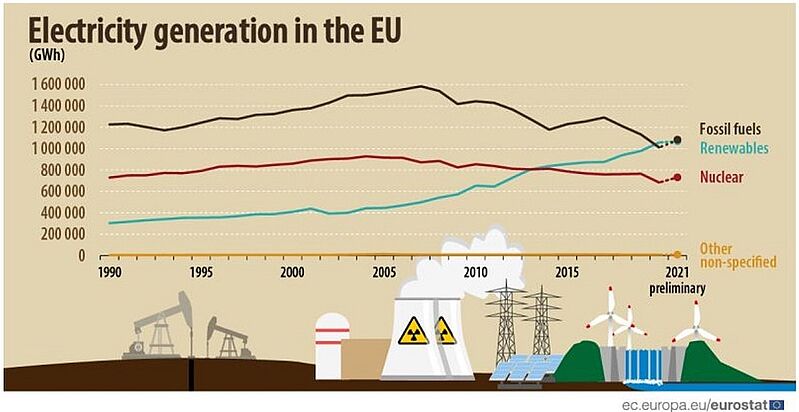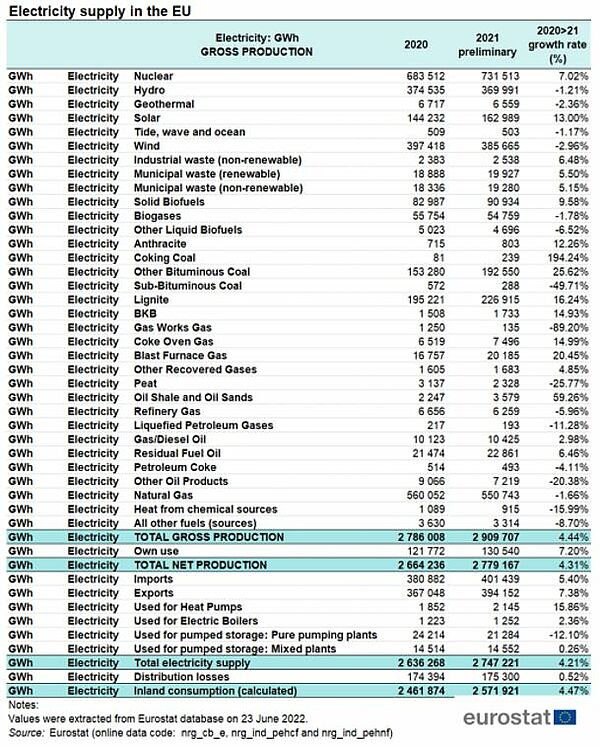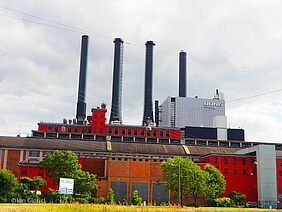Eurostat presented preliminary data on energy commodities, estimating the dynamics of energy supply in the EU in 2021 compared to 2020. Overall, statistics show that in 2021 many EU countries saw a rebound in economic activity, which emerged after a long period of restrictive measures imposed to limit the spread of COVID-19 in 2020. For example, oil and petroleum products rose by 5% after a steep fall in 2020, and natural gas was the highest in the EU for the last ten years. Solid fossil fuels increased by 13.7%, still the second lowest since 1990.
In 2021, the total electricity supply in the EU increased by 4.2% compared to 2020. As can be seen from the figure below, fossil fuels have once again become the main source of electricity generation, overtaking renewable resources, which were leading the way in 2020. The most significant increase in electricity generation from renewable sources came from solar power (+13%), as well as solid biofuels (+9.6%). At the same time, power generation from hydro and wind energy decreased due to unfavorable weather conditions – by 1.2% and 3%, respectively. The output of nuclear power plants increased by 7%.
In 2021, the list of sources that contributed the most to the EU power generation system is as follows: nuclear power (731 TWh), natural gas (550 TWh), wind power (386 TWh), hydropower (370 TWh), lignite (227 TWh), other bituminous coal (193 TWh) and solar power (163 TWh). Fossil fuels as a whole (1,078 TWh) made the largest contribution as a separate fuel group, with renewables coming in second (1,069 TWh). For a more detailed breakdown, see the table below.
According to Eurostat, domestic natural gas production continued to decline in 2021 (-8.7 % compared to 2020). The Netherlands was the largest producer of natural gas in the EU with own production of 721 PJ. Gas imports in the EU decreased by a negligible c-0.1% and exports by a significant -20.3%, resulting in a 3.9% increase in domestic natural gas consumption, as shown in the table below.
Bulgaria recorded the largest increase in domestic consumption of natural gas (+12.9%), followed by Slovakia (+11.3%) and Greece (+10.6%). Sweden showed the sharpest decrease in domestic natural gas consumption (-9.2 %), ahead of Denmark (-4.9%), Lithuania (-4.8%) and Portugal (-4.2%).
The most significant petroleum products refined in the EU were gas/diesel oil, followed by motor gasoline. As noted earlier, gross inland deliveries of all petroleum products to the EU market show a 5 percent increase in 2021. Refinery demand for primary oil (such as crude oil) increased by +2.6% whereby the supply of refined petroleum products from refineries rose by 3.2%.
Eurostat also provides data on the total heat supply in the EU in 2021, which increased by 8.9% compared to 2020. Gas, which is the most important fuel for heat production, increased by 6.3%. Solid biofuels, the second major contributor to heat production, increased even more considerably by 12.6%, while heat production from wastes increased by 5%.
